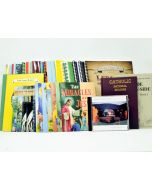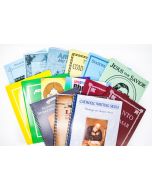Little Angel Reader B Workbook
$13.00
In stock
SKU
10469
Details
Welcome to the "Little Angel Reader" Catholic phonics series. The readers and workbooks in this series are designed to help you teach young children to read using phonics. The teaching methods used herein are based on the author's many years of practical experience teaching reading in public and parochial schools, homeschool, and private tutoring. The series incorporates long-established principles of phonics and reading instruction. We believe you will find it effective in teaching normal children to read.
Goals:
The goals of the "Little Angel Reader" program are as follows:
1. To provide systemic instruction in phonics,
2. To develop reading comprehension skills, and,
3. To support and affirm the Roman Catholic faith and traditional family values.
Reading Levels:
Reading levels for individual books in the program are as follows: Reader A: Preprimer (Late Kindergarten-or early First Grade)
Reader B: Primer (Mid-First Grade)
Reader C: First Reader (Late First Grade)
Reader D: Second Grade
Workbooks are coordinated with the readers, and therefore have the same reading levels. Due to individual differences in intelligence and ability, some children may complete the series at an earlier or later grade level than indicated.
Features of Readers:
Letter-sound relationships, or "phonograms," are taught systematically, beginning with the easiest letter sounds in "Reader A." Lessons build on skills previously learned, and gradually progress in difficulty. The most difficult phonograms and irregular phonograms are taught at the end of the series, in "Reader D."
New letter-sounds are introduced with a "picture" whose name contains the letter sound. Under each picture are rows of words containing the new letter-sound. In daily "word drills," the child sounds out the letters and blends them into words.
Following the word drill page are "stories" containing an abundance of words with the new phongoram. Story vocabulary has been carefully controlled so that students will be able to sound out a high percentage of the words using phonics skills they have learned. Maintenance of phonics skills is built into the stories, which continue to use phonetic words that have been previously learned. The stories provide practice in decoding the words in context, and also build comprehension skills.
"Sight words," which do not follow regular phonics rules, have been kept to a minimum. (Examples: the, two, come) Sight words appear in "boldface" the first time they are used in the series. The teacher is instructed to help the student pronounce unknown sight words. A few phonetic words are treated as sight words if they contain a phonogram which the student has not yet learned. Often a sight word can be partially sounded out from the consonants in the word.
To minimize the number of sight words, some "rebus" pictures (miniature picture-words) have been used, particularly in "Reader A" and "Reader B." When a student comes to a rebus, he should say the name of the rebus and continue reading the rest of the sentence.
"Review pages" are included at regular intervals, usually after 3-5 new phonograms have been learned. Whenever a review page appears, there is also a "test" over the phonograms on the review page.
Features of Workbooks: Workbooks reinforce lessons from the readers with exercises in phonics, vocabulary, reading comprehension, and handwriting. Workbooks follow the same sequence of instruction as the readers. In general, there is one workbook page for each lesson.
Softcover, 64 pages.
Goals:
The goals of the "Little Angel Reader" program are as follows:
1. To provide systemic instruction in phonics,
2. To develop reading comprehension skills, and,
3. To support and affirm the Roman Catholic faith and traditional family values.
Reading Levels:
Reading levels for individual books in the program are as follows: Reader A: Preprimer (Late Kindergarten-or early First Grade)
Reader B: Primer (Mid-First Grade)
Reader C: First Reader (Late First Grade)
Reader D: Second Grade
Workbooks are coordinated with the readers, and therefore have the same reading levels. Due to individual differences in intelligence and ability, some children may complete the series at an earlier or later grade level than indicated.
Features of Readers:
Letter-sound relationships, or "phonograms," are taught systematically, beginning with the easiest letter sounds in "Reader A." Lessons build on skills previously learned, and gradually progress in difficulty. The most difficult phonograms and irregular phonograms are taught at the end of the series, in "Reader D."
New letter-sounds are introduced with a "picture" whose name contains the letter sound. Under each picture are rows of words containing the new letter-sound. In daily "word drills," the child sounds out the letters and blends them into words.
Following the word drill page are "stories" containing an abundance of words with the new phongoram. Story vocabulary has been carefully controlled so that students will be able to sound out a high percentage of the words using phonics skills they have learned. Maintenance of phonics skills is built into the stories, which continue to use phonetic words that have been previously learned. The stories provide practice in decoding the words in context, and also build comprehension skills.
"Sight words," which do not follow regular phonics rules, have been kept to a minimum. (Examples: the, two, come) Sight words appear in "boldface" the first time they are used in the series. The teacher is instructed to help the student pronounce unknown sight words. A few phonetic words are treated as sight words if they contain a phonogram which the student has not yet learned. Often a sight word can be partially sounded out from the consonants in the word.
To minimize the number of sight words, some "rebus" pictures (miniature picture-words) have been used, particularly in "Reader A" and "Reader B." When a student comes to a rebus, he should say the name of the rebus and continue reading the rest of the sentence.
"Review pages" are included at regular intervals, usually after 3-5 new phonograms have been learned. Whenever a review page appears, there is also a "test" over the phonograms on the review page.
Features of Workbooks: Workbooks reinforce lessons from the readers with exercises in phonics, vocabulary, reading comprehension, and handwriting. Workbooks follow the same sequence of instruction as the readers. In general, there is one workbook page for each lesson.
Softcover, 64 pages.
We found other products you might like!



